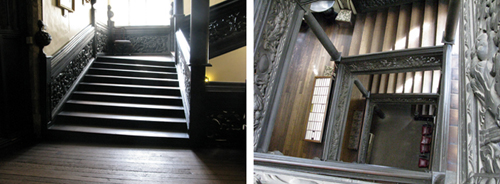The Black Staircase was constructed by Bishop John Cosin in the late seventeenth century. Cosin inherited the Bishopric of Durham after the English Civil War. Many of the buildings were in bad condition and there was lots of work to be done – but, as Bishop, Cosin had the resources to do it.
Much of the carved woodwork in the Castle and Cathedral dates from his period, and the staircase would have been the piece de resistance of his Castle refurbishment.
It was designed as a flying staircase, meaning that it would have had no vertical supports. Each stair was embedded into the wall, with the weight deflected all the way from the top to the bottom. Unfortunately, Cosin's builders miscalculated and the staircase began to lean soon after its construction.
To stabilise the structure, wooden posts were put in. These remain in place today.
Its name refers to its dark colour, which is actually very dark brown, not black.

Two views of the Castle's 17th century Black Staircase, the one to the left showing the way it leans, and the one to the right showing the wooden posts that were put in to stabilise it. The staircase is an example of a common problem in boundary-pushing design – experiments that are too daring and falter.
© Jeffrey Veitch


